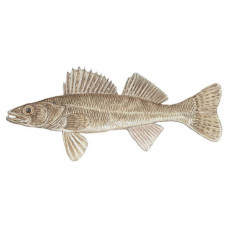Latin name
Stizostedion vitreum x S. canadense
Other names
No information
Identification
The saugeye's body is more similar to that of a walleye than a sauger, although the dorsal fin is sometimes spotted (it is in the sauger, not the walleye). It also has saddle-like markings on the back and sides like the sauger, and the caudal fin has a white border on the lower lobe like the walleye. The saugeye also has a dark spot on the webbing of the spiny dorsal fin. The body may have a yellowish tinge.
Distribution
Saugeye has been introduced into U.S. reservoirs from western Ohio, Kentucky and Tennessee to the eastern Dakotas and as far south as Oklahoma.
Habitat
Like their sauger parent, saugeye are more tolerant of turbid or muddy water than walleye, and appear to be better suited to reservoirs with high water exchange rates (which increase turbidity). However, the introduction of saugeye into new waters is still in its early stages.
Size
The world record for all tackle is a 12-pound, 13-ounce fish from Ohio. The typical length of a Sauger is about 15 inches and usually ranges from 10 to 24 inches.
Life history and Behavior
Unlike some hybrid species, saugeye are not sterile and can produce offspring from either parent. Spawning occurs in tributaries or tailwaters at 40° to 50°F.
Food and feeding habits
Small fish are the main food of the saugeye. Shad are a favorite in many lakes and rivers.
Reproduction
No information
| Features | |
| Habitat | Pelagic |
| Life span, years | No information |
| Maximum body weight, kg | 5.8 |
| Maximum length, cm | No information |
| Sailing speed, m/s | No information |
| Threat to people | Edible |
| Way of eating | Predator |
Saugeye
Tags: Saugeye


